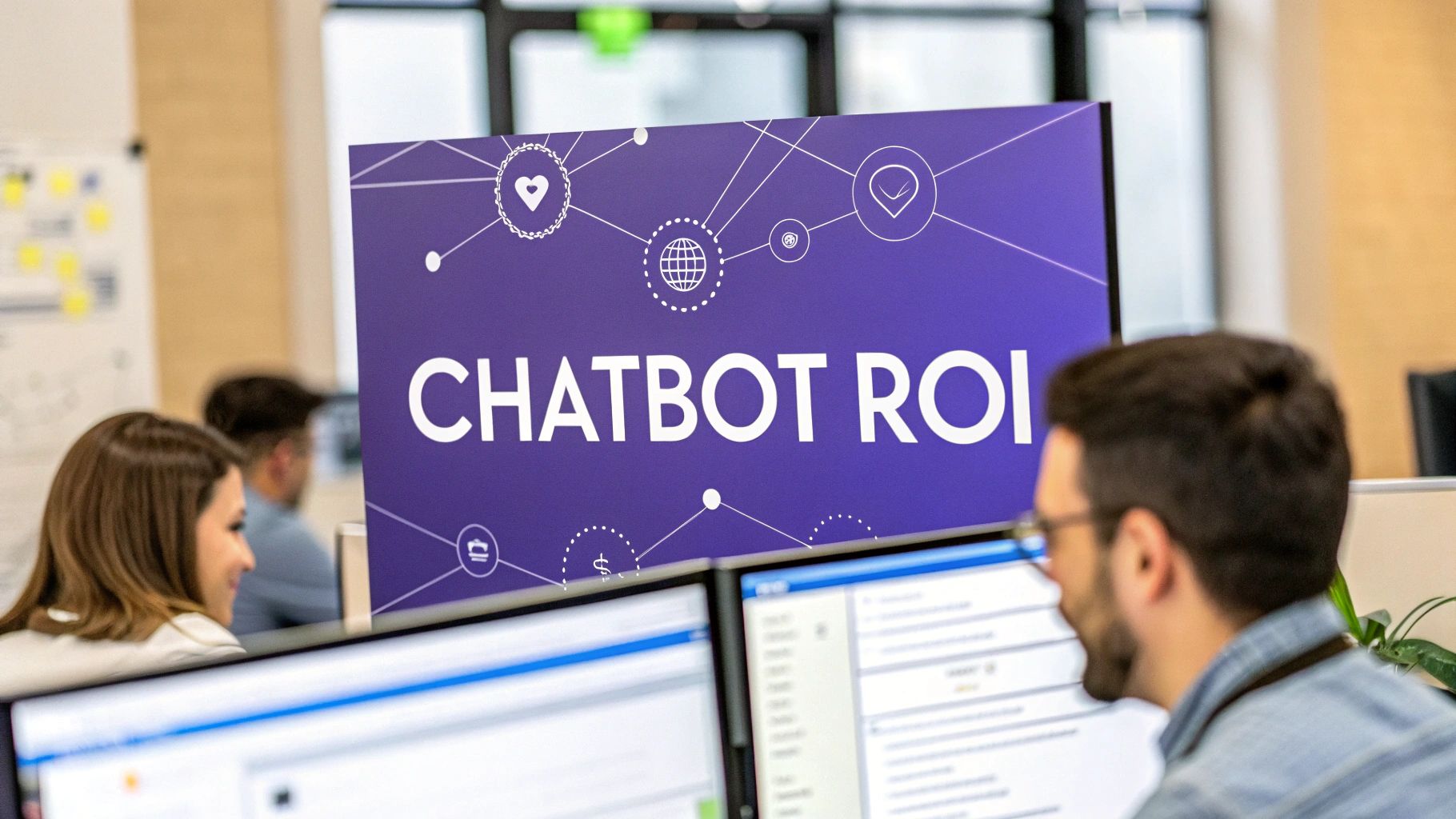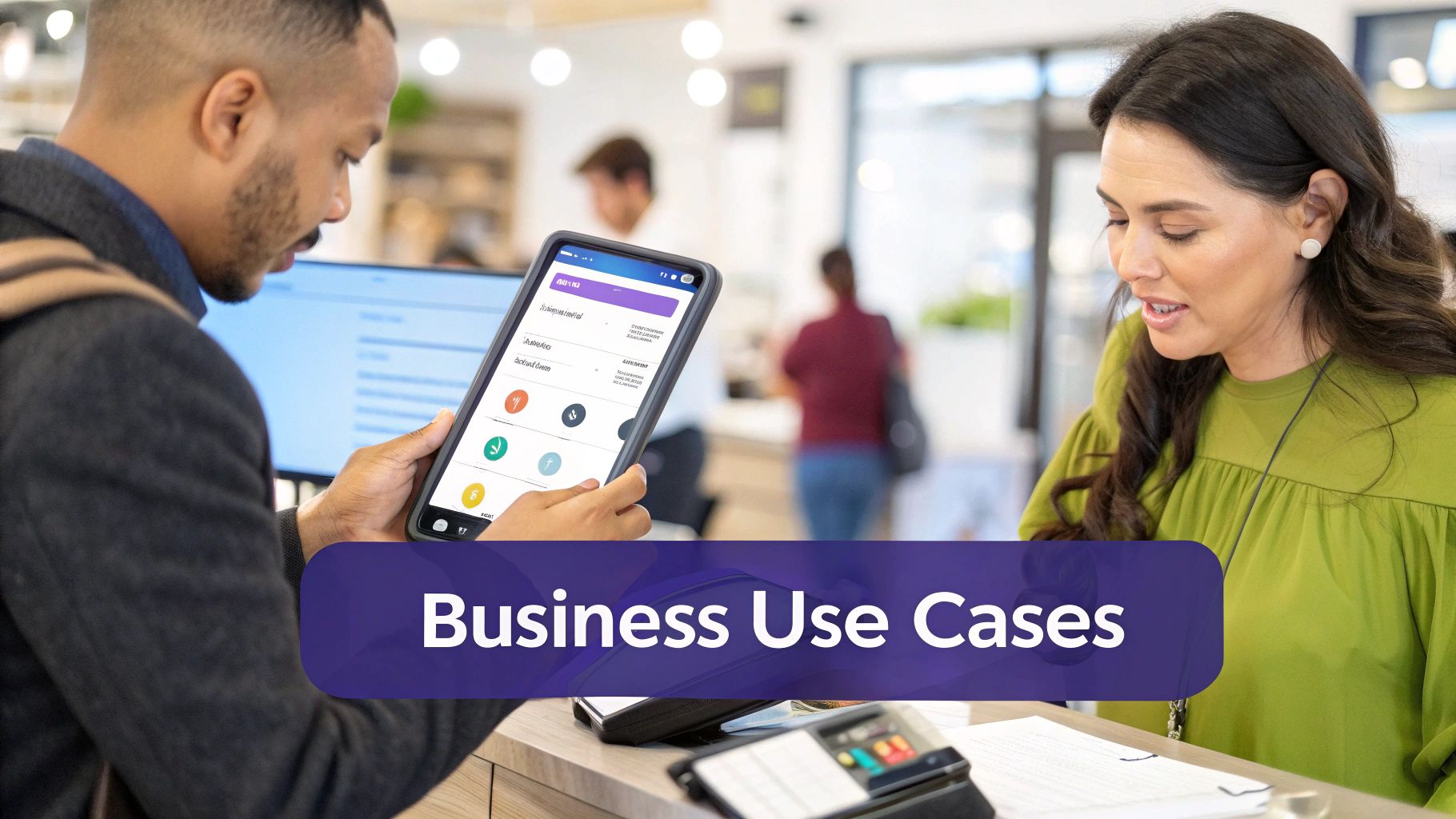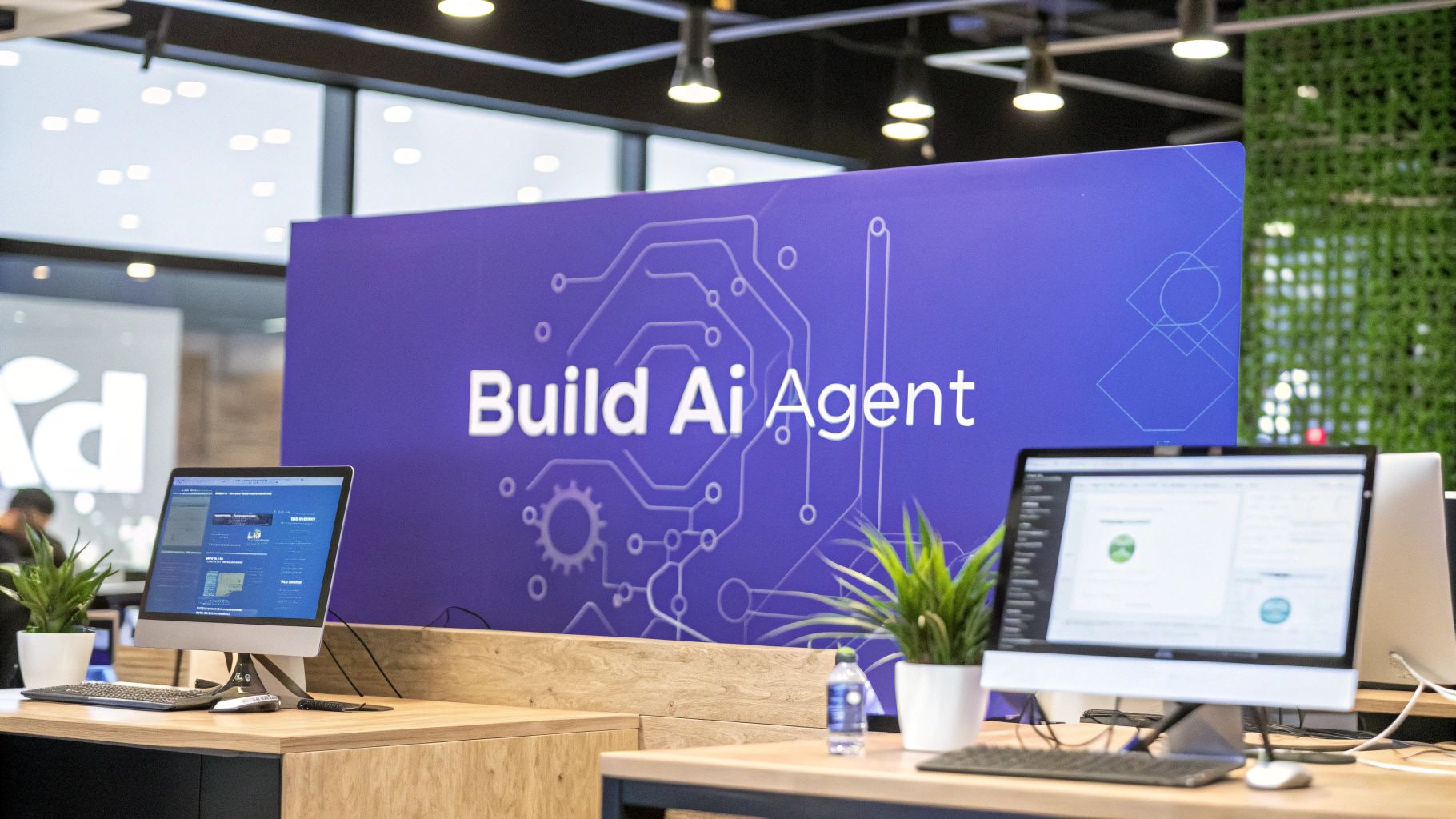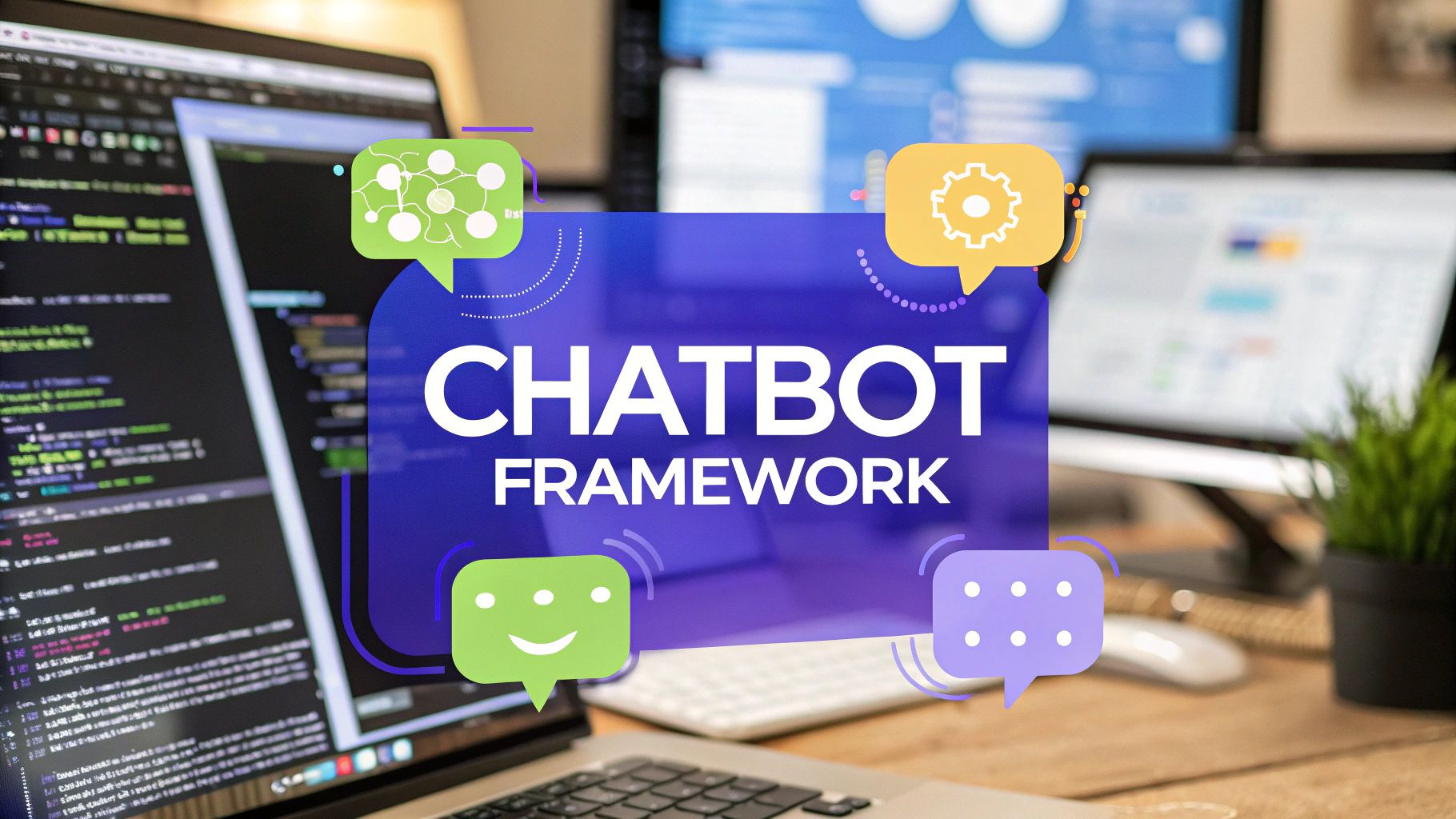Enterprise Chatbot Solutions for Operations and ROI
Discover enterprise chatbot solutions that streamline operations, boost efficiency, and offer practical implementation tips for scalable AI.

Trying to understand enterprise chatbot solutions? It’s easy to picture the simple bots you see on small websites, but what we're talking about is a completely different league. Think of them as a capable digital workforce for your entire organization, not just a basic Q&A tool.
These advanced systems are built to handle complex customer requests, connect with your core business software, and deliver personalized support across multiple departments.
What Are Enterprise Chatbot Solutions?
When most people think of chatbots, they imagine the little pop-up window on a website that can answer a few basic questions. An enterprise chatbot solution is something else. It's a sophisticated, AI-powered platform designed to operate at a massive scale, handling difficult processes and integrating into a company’s existing software.
Instead of just responding to keywords, these platforms use advanced artificial intelligence to get the context and intent behind what a user is asking. This lets them manage multi-step conversations and perform tasks that would normally require a person.
For example, a simple bot might answer, "Where is my order?" with a link to a tracking page. An enterprise bot can access your logistics system, give a real-time update, and even start a return process if that's what the customer wants.
More Than Just a Customer Service Tool
While improving customer service is a common starting point, the true scope of an enterprise solution goes far beyond the help desk. They act as a versatile digital workforce that can be put to work across different departments to automate and simplify how things get done.
A few common applications include:
- Sales and Marketing: Engaging website visitors, qualifying new leads, and scheduling demos with sales reps.
- Human Resources: Helping new hires with onboarding, answering questions about company policies, and processing time-off requests.
- IT Support: Walking users through common tech issues, resetting passwords, and creating support tickets automatically.
The core idea is to automate high-volume, repetitive tasks. This frees up your human teams to focus on more strategic work. It’s a shift that boosts efficiency and makes employees' jobs better by getting rid of tedious administrative work.
The Power of Integration and AI
What really sets enterprise chatbots apart is their ability to connect with other business-critical systems. They can link up with your Customer Relationship Management (CRM) software, Enterprise Resource Planning (ERP) systems, and inventory management databases. This integration allows the chatbot to pull and push data in real time, giving it the power to provide accurate, personalized information and complete tasks from start to finish.
This is all made possible by the powerful AI at their core. These systems rely on advanced technologies to learn, reason, and communicate in a way that feels natural and helpful. To get a better handle on the technology that drives these bots, check out our guide on what is conversational AI.
The Core Features of Enterprise Chatbots
So, what’s the real difference between a basic, rule-based bot and a powerful enterprise chatbot? It comes down to a specific set of features built for scale, complexity, and integration. These aren't just bells and whistles; they're the engine that lets a chatbot move beyond simple Q&A and become a genuine part of your digital team.
At the heart of it all is Natural Language Processing (NLP). This is the tech that lets the chatbot understand human language, including typos and slang. It’s the difference between a bot that only gets the keyword "password" and one that understands "I forgot my login info" or "can't get into my account."
Unified Customer Experience and System Connectivity
A huge part of an enterprise solution’s job is to provide a consistent experience, no matter where a customer is interacting with you. This is what's known as omnichannel support. A conversation could start on your website, move to your mobile app, and get a follow-up notification on social media, and the chatbot keeps the context the whole time.
That kind of seamless journey is only possible with deep integrations into your other business systems. An enterprise chatbot has to plug into software like:
- Customer Relationship Management (CRM): Think Salesforce. The bot can pull up customer history to personalize the conversation on the fly.
- Enterprise Resource Planning (ERP): With access to platforms like SAP, a bot can check inventory, track an order, or process a return without needing a person.
- Helpdesk Software: The bot can create support tickets and hand off complex issues to a human agent, all without losing the conversation history.
This connectivity turns the chatbot from an isolated information box into a central hub for getting things done. It can perform tasks right inside your existing workflows.
The infographic below shows how these core pieces, AI-driven conversations, system integrations, and business process automation, all come together to create a complete digital workforce.
As you can see, a true enterprise solution is a platform built on all of them working together.
While a standard chatbot can handle basic questions, an enterprise solution is designed to operate as a fully integrated part of your business infrastructure. The table below breaks down the key differences.
Key Features of Enterprise vs. Standard Chatbots
A standard chatbot answers questions, while an enterprise chatbot solution takes action and automates entire workflows securely and at scale.
Advanced Security and Actionable Analytics
When you're handling customer data, security can't be an afterthought. Enterprise chatbot solutions are built with advanced security protocols to protect sensitive information and stay compliant with data protection laws. This means data encryption, secure authentication, and strict access controls are all part of the package.
Beyond just keeping data safe, these platforms give you very detailed analytics and reporting. We're not just talking about counting how many conversations the bot had. We're talking about tracking key performance indicators (KPIs) that actually mean something, like:
- Resolution Rate: What percentage of issues did the bot solve without needing a person?
- Customer Satisfaction Scores: How did users rate the interaction?
- Containment Rate: How many conversations were successfully kept within the automated channel from start to finish?
This data gives you a powerful window into customer behavior, common friction points, and opportunities to make your services better.
By analyzing conversation logs and performance metrics, businesses can spot recurring issues or emerging trends. This feedback loop is useful for refining everything from product features to support processes.
The numbers show a clear trend. Research suggests that 78% of organizations will be using AI in at least one business function by 2025. B2B companies are leading the way, making up 58% of chatbot implementations. Adoption in large companies (over 5,000 employees) is already hitting 60%, which shows how much confidence bigger players have in these tools. If you want to dig deeper into the data, you can explore more AI chatbot adoption stats on Fullview.io.
Knowing these core features is the first step. It helps you look past the hype and choose a platform that truly fits your company's needs.
How Businesses Use Enterprise Chatbots Today

It’s one thing to talk about the features of enterprise chatbot solutions, but it’s another to see how they hold up in the real world. Across industries, large companies are putting these advanced bots to work in practical ways, solving real problems for both their customers and their own internal teams.
These aren't just side projects or experiments. For many, chatbots have become core parts of daily operations, showing just how versatile these platforms can be.
Transforming Customer Service and Support
The most common place you'll find an enterprise chatbot is right on the front lines of customer service. Here, they act as the first point of contact for countless questions, providing instant answers and resolutions around the clock. No more waiting in a queue for a human agent.
They handle a lot more than just basic FAQs. For example, a customer can chat with a bot to:
- Track an Order: The chatbot can connect to a logistics system to give real-time shipping updates.
- Schedule an Appointment: It can check a calendar, find an open slot, and book a meeting or service call on the spot.
- Troubleshoot an Issue: The bot can guide a user through step-by-step solutions for common technical problems.
By automating these high-volume, low-complexity interactions, businesses free up their human support agents. This lets experienced team members pour their energy into the most complex and sensitive customer issues that really do need a human touch.
Adoption rates show just how widespread this has become. Financial services are leading the charge, with 92% of North American banks now using AI chatbots. Even in a highly regulated field like healthcare, bots are present in 31% of customer service applications. Customers are on board, too. A significant 62% of people say they'd rather talk to a chatbot than wait for a human agent. You can read more about these AI chatbot statistics to get the full picture.
Driving Sales and Marketing Efforts
Beyond the support desk, enterprise chatbots have become powerful tools for sales and marketing teams. They engage potential customers the moment they land on a website, turning what was once passive browsing into an active, helpful conversation.
A chatbot can proactively ask a visitor if they need help finding something, qualify them as a lead by asking a few targeted questions, and offer personalized product recommendations based on their browsing behavior.
Here’s a quick look at how they help move prospects through the sales funnel:
- Lead Qualification: The bot gathers key info from a prospect, like their company size, budget, or specific needs.
- Meeting Scheduling: Once a lead is qualified, the bot can tap into a sales rep’s calendar to book a demo or a call.
- Product Guidance: For e-commerce sites, a bot can act as a virtual shopping assistant, helping customers find the perfect product.
This automated process lets the sales team spend its time talking to well-informed, high-intent prospects, which helps shorten the sales cycle and boost conversion rates.
Streamlining Internal Operations
The impact of enterprise chatbots isn't just limited to customer-facing roles. Many companies are deploying them internally to make their employees' lives easier and more efficient. Think of them as digital assistants for various departments.
Human Resources (HR) is a perfect example. An HR chatbot can field a huge volume of common employee questions and tasks, including:
- Onboarding New Hires: Guiding new employees through their first days, from filling out paperwork to learning company policies.
- Answering Policy Questions: Providing instant answers about benefits, vacation time, or expense reporting.
- Processing Requests: Automating simple workflows like leave requests or updating personal information.
In the same way, an IT helpdesk bot can help employees with common tech headaches like password resets or software installation guides. This cuts down on the number of support tickets and lets the IT staff focus on more significant, system-wide issues.
By taking care of these routine internal tasks, companies create a more efficient and supportive work environment. Employees get what they need instantly, allowing them to stay focused on their real jobs without unnecessary delays.
Thinking about getting an enterprise chatbot? It's a big move, so it's smart to ask what the real return is. The payoff goes way beyond just adding a new tech toy to your website. When you get it right, a chatbot solution can make a real difference to your bottom line, your team's agility, and how customers see you.
The most obvious win is a serious drop in operational costs. Chatbots are perfect for handling the flood of repetitive, high-volume questions that eat up most of your support team's day. Automating this frees up a ton of resources, which translates directly into lower staffing costs.
Driving Down Costs and Boosting Efficiency
By taking over the routine stuff, chatbots let your skilled human agents focus on the complex, high-value problems where their expertise actually matters. This makes your support team more effective and boosts job satisfaction by cutting out the tedious work. The financial impact is huge.
The savings can be pretty dramatic. Customer support automation has been shown to slash costs by up to 92%, saving companies around USD 4.13 for every interaction a bot handles instead of a human. If you want to dig into the numbers, you can explore detailed reports from Mordor Intelligence. It paints a clear picture of a strong return on investment.
Beyond just saving money, enterprise chatbot solutions deliver massive gains in operational efficiency. Unlike a human team, a chatbot works 24/7 without needing a coffee break. That means instant support for customers in any time zone, so your business is always on and ready to help.
One of the biggest operational wins is scalability. A chatbot can juggle thousands of conversations at once during a sudden traffic spike, something that would completely overwhelm even a large support team. This ensures you can deliver consistent service, no matter how busy things get.
Improving the Customer Journey
A better customer experience is another major perk. In an era of "I want it now," nobody likes to wait. Chatbots get rid of queues and give people immediate answers, which is a huge boost for customer satisfaction. One report found that 62% of people would rather use a chatbot than wait for a human agent to become available.
This instant, personalized support helps build much stronger customer relationships. A chatbot hooked up to your CRM can greet customers by name, pull up their order history, and offer recommendations that actually make sense for them. That level of personal attention makes customers feel seen and valued, which is exactly what builds loyalty. If you're looking to automate more of your support workflows, our guide on help desk automation has more strategies you can use.
Unlocking Actionable Business Insights
Finally, every single conversation a chatbot has is a goldmine of data. These interactions create a rich, real-time feedback loop straight from your customers. By analyzing conversation logs, you can uncover some incredibly powerful insights into what your customers are thinking and feeling.
This data helps you make smarter business decisions by flagging things like:
- Common Pain Points: Are tons of people asking about the same product issue or getting stuck at the same step in checkout?
- Product Gaps: What features or services are customers constantly asking for?
- Emerging Trends: Are new questions popping up that could signal a shift in the market?
With this information, you can proactively improve your products, tweak your marketing, and optimize the entire customer experience. A chatbot doesn't just solve problems; it helps you find opportunities to grow and improve your whole operation.
Choosing and Implementing the Right Solution

Alright, you’re sold on the idea of an enterprise chatbot. Now what? Moving forward requires a clear plan, not just a cool piece of tech.
The very first step is to figure out exactly what you want the chatbot to do. Are you trying to slash support costs? Generate more qualified leads? Or maybe just make internal processes run a whole lot smoother?
Defining your goals upfront is the most important part of this entire process. Without a clear target, it's dangerously easy to get distracted by flashy features and end up with a tool that doesn't solve a real business problem.
How to Evaluate Potential Vendors
Once you know your goals, it's time to start looking at vendors. Not all chatbot platforms are created equal, and the "best" one is really just the one that best fits your specific needs. You'll need to look closely at a few key areas to find the right partner.
When you're vetting vendors, keep these points in mind:
- AI and NLP Capabilities: How well does the bot actually understand human language? Ask for a live demo and throw some curveball questions at it. See if it can handle complex queries and follow a conversation's context without getting lost.
- Integration Options: A chatbot is most powerful when it’s connected to the tools you already use. Check if the platform can easily plug into your CRM, ERP, and helpdesk software. To get a better handle on how this works, you can learn more about using an API for a chatbot in our related article.
- Scalability and Performance: The solution has to handle your current chat volume and be ready to grow with you. Ask about performance benchmarks and how the system manages sudden spikes in traffic, because they will happen.
- Security Standards: Your chatbot will be handling sensitive customer and company data. It absolutely must meet strict security and compliance standards. Make sure the vendor follows industry best practices for data protection and can prove it.
These factors will help you cut through the noise, narrow down your options, and pick a partner that can support your long-term strategy.
The Implementation Roadmap
After you’ve chosen a vendor, the real work begins. This is where you turn your plans into a functional, helpful chatbot that both customers and employees actually want to use. This phase involves careful design, thorough training, and a staged rollout.
A typical implementation process follows a few key steps:
- Design Conversation Flows: Start by mapping out the most common conversations you expect the bot to have. Think of it like creating a script with logical paths that guide users to a successful outcome, whether that's an answer, a support ticket, or a booked demo.
- Train the Bot: You need to feed the chatbot your company's data, things like knowledge base articles, product specs, and historical support tickets. This is what helps it understand your specific business and answer questions with confidence and accuracy.
- Launch a Pilot Program: Before unleashing the bot on everyone, roll it out to a small, controlled group of users. This pilot test is your chance to gather real-world feedback and fix any kinks in a low-risk setting.
The goal of a pilot isn't perfection; it's learning. Use the feedback from this initial group to refine the chatbot's responses and conversation flows. It will make for a much smoother experience when you go live for everyone.
When deciding on the best approach for building out your chatbot, companies often weigh different development models, including the pros and cons of nearshore vs offshore outsourcing for AI teams.
Ensuring a Successful Rollout
Going live is a huge milestone, but the work doesn't stop there. A successful chatbot implementation demands ongoing attention. You need to monitor its performance, listen to what users are saying, and make continuous tweaks to keep it effective.
For deployment, it’s no surprise that cloud-based models are the most popular, accounting for 78.4% of the market share thanks to their scalability and security. That said, hybrid models are gaining traction, especially in regulated industries that need more control over where their data lives.
To get the most out of your investment, you have to commit to continuous improvement. Regularly check the conversation logs. See where the bot is knocking it out of the park and where it’s fumbling. This data-driven approach will help you make targeted improvements that keep your bot aligned with both your business goals and your users' expectations.
The Future of Enterprise Chatbots and AI
The world of enterprise chatbot solutions isn't just evolving; it's accelerating, thanks to huge leaps in artificial intelligence. The next generation of chatbots is already here, and they're doing a lot more than just answering questions. We're seeing a shift from reactive tools to proactive assistants that anticipate what a user needs, often before they even ask.
Imagine a chatbot that notices a customer is stuck on your checkout page and immediately offers help. Or one that flags a high-value lead showing clear buying signals for a sales rep. This is the future, moving to proactive engagement that makes every touchpoint smarter and more intuitive.
The Rise of Generative AI and Voice
At the heart of this shift are the rapid advancements in Large Language Models (LLMs). Generative AI is making chatbot conversations feel startlingly natural and human. Instead of being stuck on rigid scripts, these bots can now handle complex, multi-turn dialogues and generate creative, context-aware responses on the fly.
But it’s not all about text. The other big trend is the growth of voice-enabled bots and their seamless integration with smart assistants. People are getting used to hands-free, conversational interactions, and businesses are catching on. They're building chatbots that can understand and respond to spoken commands, creating a much smoother experience across all devices.
The numbers tell the same story. The global enterprise chatbot market was valued at around USD 7.76 billion in 2024 and is projected to hit USD 27.29 billion by 2030. That’s a compound annual growth rate of about 23.3%.
Staying on top of these trends is no longer optional. Getting ready for this next wave of automated interaction will keep your customer and employee support strategies competitive for years to come.
Frequently Asked Questions
Thinking about bringing an enterprise chatbot on board? It's a big step, and naturally, you've got questions. Here are a few of the most common ones we hear from businesses just like yours.
How Secure Are Enterprise Chatbots with Sensitive Data?
This is usually the first question people ask, and for good reason. The short answer is: very secure. These platforms aren't like your average consumer app; security is baked into their design from the ground up.
They use heavy-duty measures like end-to-end encryption, strict access controls, and undergo regular security audits to keep data locked down. They’re also built to comply with strict regulations like GDPR and HIPAA, which is why industries like finance and healthcare trust them with their most sensitive information.
What Is the Biggest Challenge When Integrating a Chatbot?
Hands down, the trickiest part is almost always connecting the chatbot to all your existing company software, your CRM, ERP, and other core systems. It’s not a simple plug-and-play situation.
A successful integration needs careful planning to make sure data flows smoothly and correctly between all these different platforms. If your chatbot can't pull the right information from your customer database or inventory system, its ability to give accurate, personalized answers will be seriously limited. This step is what separates a chatbot that just answers questions from one that actually gets things done.
The most effective enterprise chatbot solutions act as a central hub, pulling data from multiple sources to provide a single, correct answer. Without this deep integration, the bot operates with incomplete information, which can frustrate users and reduce its overall value.
How Do You Measure the ROI of a Chatbot?
Measuring the return on investment (ROI) comes down to tracking the right metrics. You need to look at specific key performance indicators (KPIs) that give you a clear, undeniable picture of the chatbot's impact.
Here are the big three to keep an eye on:
- Cost Reduction: This one’s the most straightforward. Calculate your savings from a lower volume of support calls and the number of issues resolved without any human help.
- Customer Satisfaction (CSAT): Are users actually happy with the experience? Use simple post-chat surveys to get a direct pulse on how people feel after interacting with the bot.
- Resolution Rate: Track the percentage of user questions the chatbot can successfully handle all on its own. This tells you how effective it really is.
These data points help you build a rock-solid business case and show exactly how much value the chatbot is bringing to your operations.
Ready to see how a custom AI agent can transform your operations? Chatiant lets you build powerful chatbots trained on your own data. Start building your AI assistant today


